Our natural approach to social VR
We've been hard at work on the technical side, but thinking a lot about design philosophy too, figuring out what will make people want to use Tivoli Cloud VR and keep coming back. We've come to realize there's a lot in common here with urban planning and desire paths.

Our mission in making Tivoli Cloud VR is simple. We want to create an easy-to-use, scalable, and delightful social VR service that people really enjoy using. We want the people who use it to feel terrifically empowered by the limitless possibilities of VR, while at the same time feeling extremely cozy and at home. We've been hard at work on the technical challenges of social VR, but thinking a lot about design philosophy too, figuring out what will make people want to use Tivoli Cloud VR and keep coming back. We've come to realize there's a lot in common here with urban planning and the phenomenon of desire paths. Desire paths are the shortcuts and dirt paths that diverge off the planned map. It's urban planning democracy where you vote with your feet.
Creating a truly scalable, multi-user spatial computing architecture is a complex computer engineering kind of problem. But making it into an experience that is delightful, empowering, and cozy? That's a listening-and-paying-attention-to-people kind of problem. People interact with reality in a way which can’t be understood with flow-charts, but can be understood through empathetic engagement: listening, watching, and making the design decisions that respond to the needs of the actual people who use it.
Design without empathy creates experiences that are mediocre, lifeless and sometimes oppressive. Looking at almost any modern cityscape, there's always blocky, overly designed buildings which fail to warm the heart, designed as an expression of whatever school of architecture is trending, maybe as a tribute to the designer's genius, or hoping for a place in architecture history, but never as places for people to really feel cozy or productive.
Compare a master-planned community like London's Thamesmead (above) to the meandering streets of a 1,000 year old town in the French Alsace (below). You'll be astonished by the arrogance and coldness of the former, and delighted and charmed by the attractive harmony of the narrow winding passages of the latter. Where would you prefer to live?
The villages of the Alsace were not master planned. Buildings were built with roughly cut wood, irregular bricks, walls made from straw, dung, clay and plaster. Why is it that a medieval village, built with crude technology and materials, by relatively uneducated people, would be so much more appealing and harmonious than the product of planning, precision engineering and knowledge of the compressive strength of concrete?
The answer is so simple. It is the product of a human community. It is a space created by the people who must live inside it. In A Pattern Language, architect Christopher Alexander writes “..most of the beautiful places of the world were not made by architects but by the people. “
Tivoli Cloud VR is made by people who they themselves want to co-exist in a delightful and powerful virtual world. We've been in the trenches and have been listening to social VR user requests for years. Rather than handing down ill-informed design directives, we want to build around the things you've asked for. We want you to tell us what you want, how you want it to work, and what will keep you coming back. We'll try our best to give it to you.
Please join our official Discord server, especially our #feature-requests channel, and talk to us!
